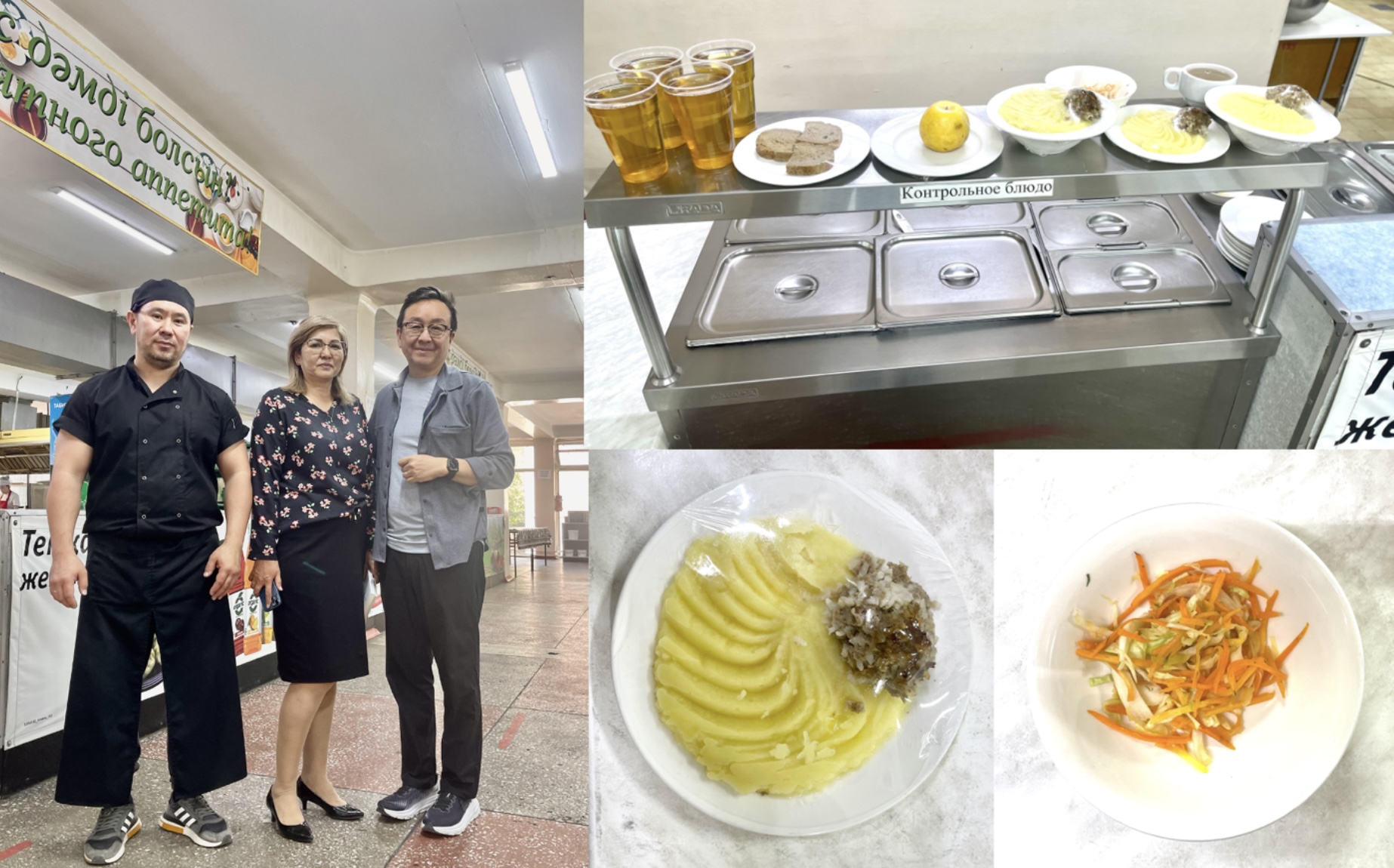ASTANA – Adoption of new nutritional standards for school meals based on Scandinavian example could protect students from chronic non-communicable diseases such as diabetes and obesity, Almaz Sharman, president of the Academy of Preventive Medicine and a member of the American Health Association, told The Astana Times.

Almaz Sharman. Photo credit: wikipedia.org
School meals are a crucial source of nutrition, and unbalanced meals can put children at a much higher risk of health problems when their bodies and brains are still growing.
According to Sharman, an expansion of nutrient-dense balanced hot meals to all schools in Kazakhstan would pay long-term dividends for the nation’s health and create a long-term shift in Kazakh food culture.
“Based on our study conducted in collaboration with the United Nations Children’s Fund in several regions of Kazakhstan, including Turkistan, West Kazakhstan [regions], and Shymkent city, it was found that school menus tend to be high in sugar, salt, and saturated fat. Addressing this issue requires a greater emphasis on promoting knowledge about healthy eating among teachers, parents, and schoolchildren,” said Sharman.
Balanced meals would promote optimal child development and prevent the onset of chronic disease early on.
“Unhealthy diets are main contributors to the global increase in chronic non-communicable diseases such as diabetes, obesity, hypertension, cancer, and cardiovascular diseases,” he said.
“School meals should be delicious, appealing, nutritious, healthy, and safe. Cultural and ethnic food preferences of schoolchildren should also be considered,” he added.
Embracing the Scandinavian school nutrition model
Sharman visited Sweden and Finland, renowned for their advanced education systems and exemplary school nutrition practices. Schools and parents there have ramped up efforts to provide pupils with healthier meals and to establish good eating habits.

Sharman (M) visited a Swedish school and met with the chefs to learn the peculiarities of their meal plan. Photo courtesy of the author.
The canteen of the Swedish schools offers children the same quality of food that one would expect at an upscale restaurant.
“When I met these two tall guys, I thought they were Metallica rockers. And somehow, I was not mistaken. Their names are Mikel and Gustav. They are chefs at the school restaurant. Yes, chefs, not cooks and in a restaurant, not a school cafeteria. This is how school meals are treated in Sweden,” said Sharman.
“For only 0.93 euros ($US1.01), you can feed the children delicious Swedish meatballs, provide them with a large selection of vegetables and salads, and wash it all down with fresh milk,” he added.
The school meals in Finland adhere to the principles that food should be “nutritious, enjoyable, tasty, safe, ecosmart and inclusive.”
“The latter here refers to the integration of school meals into educational processes. A buffet system has been adopted here: dishes are not laid out in advance on plates, but they allow schoolchildren to make their own choice. Together with them, teachers have lunch, who suggest which dishes and what quantities to put on a plate, explaining the benefits of a healthy diet,” he said.
The school lunch should provide around a third of children’s daily energy needs and include vegetables, meat, poultry or fish, and milk or dairy products, said Sharman.
“In Finnish schools, any sale or distribution of sugary and energy drinks, as well as chips, sweets, cookies, and other sweets, is prohibited. In addition, we saw no fast food restaurants nearby. All this aligns with the key principles of the Finnish model of free and public school meals which is designed to be attractive, balanced, safe, supervised, appropriate, and sustainable,” he said.
As well as serving good food, the rules also encourage schools to keep pupils involved in learning about the principles of healthy eating.
Almaty’s approach to school meals
Almaty public schools are doing their part by offering free hot meals for all primary school students this academic year.

Sharman (R) visited No.135 secondary school in Almaty. On the day of the visit they served beef meatballs with sauce and mashed potatoes as the main course. Photo courtesy of the author.
Sharman visited No.135 secondary school in Almaty, located in one of the central districts of the city. Alongside its commendable educational standards and experienced teaching staff, the school received recognition for providing quality meals to its students.
“On the day of our visit, the menu for children aged 7-10 included approximately 60 grams of fresh vegetable salad, 70 grams of beef meatballs with sauce, 100 grams of mashed potatoes, 20 grams of rye-wheat bread, a whole apple, and 200 milliliters of natural juice,” said Sharman.
“While the meals we observed at the school appeared nutritious, the menu itself does not explicitly state the calorie content or the proportions of proteins, fats, carbohydrates, sugar, salt, and other nutritional components,” he added.
The menu for schools in Almaty is determined by the city akimat’s (mayor’s office) education department. It undergoes changes every four weeks and is planned for the entire academic year.
“It is important that the school menu is developed based on modern nutritional science recommendations, taking into account these essential aspects of a balanced diet,” said Sharman.
A balanced diet and regular exercise are essential.
“The proximity of a nearby park and private sports facility, allowing children to engage in physical activities and recreational pursuits after classes, also added to its [the school’s] appeal,” said Sharman.
Recommendations for optimizing school meals
Sharman’s nutritional science recommendations include making milk available and cutting down on sweet and deep-fried meals, as well as modernization of kitchen equipment and rebooting food education among children, parents and teachers.
Artificial sweeteners, high-calorie snacks and fried items should be off the shelves, said Sharman.
“Sugar-containing drinks like compote, jelly, and sweetened tea carry risks of metabolic disorders, diabetes, obesity, and other health issues. Even fruit juices can have higher sugar concentrations than Coca-Cola, so such drinks should be limited,” he said.
“The school menu should include milk and emphasize the importance of dairy products, particularly fermented milk products. They are valuable sources of complete protein, vitamins, and calcium necessary for children’s growth,” he added.
When developing the school menu, it is essential to base it on scientifically supported recommendations for healthy nutrition among children of different age groups.
“The menu should provide about one-third of the daily energy needs with 15% represented by proteins, 55% by carbohydrates, and 30% by fats. It is crucial to limit the intake of sugar, salt, and saturated fats, especially in processed foods,” said Sharman.
Finding an optimal meal plan is not an easy task. “No country in the world has achieved perfection in school meals, including Sweden, Finland and Kazakhstan,” said Sharman.
“Organizing meals for children is a highly complex and responsible process involving considerations of safety, logistics, economics, and the cultural and taste preferences of children and parents. However, the most crucial aspect is having a deep understanding of the role of nutrition in enhancing the physical and mental well-being of schoolchildren,” he added.
“The upcoming provision of free hot meals to all primary school students in Kazakhstan is of immense significance. This state initiative represents a vital investment in the health and intellectual potential of future generations of Kazakhstan’s citizens,” said Sharman.


